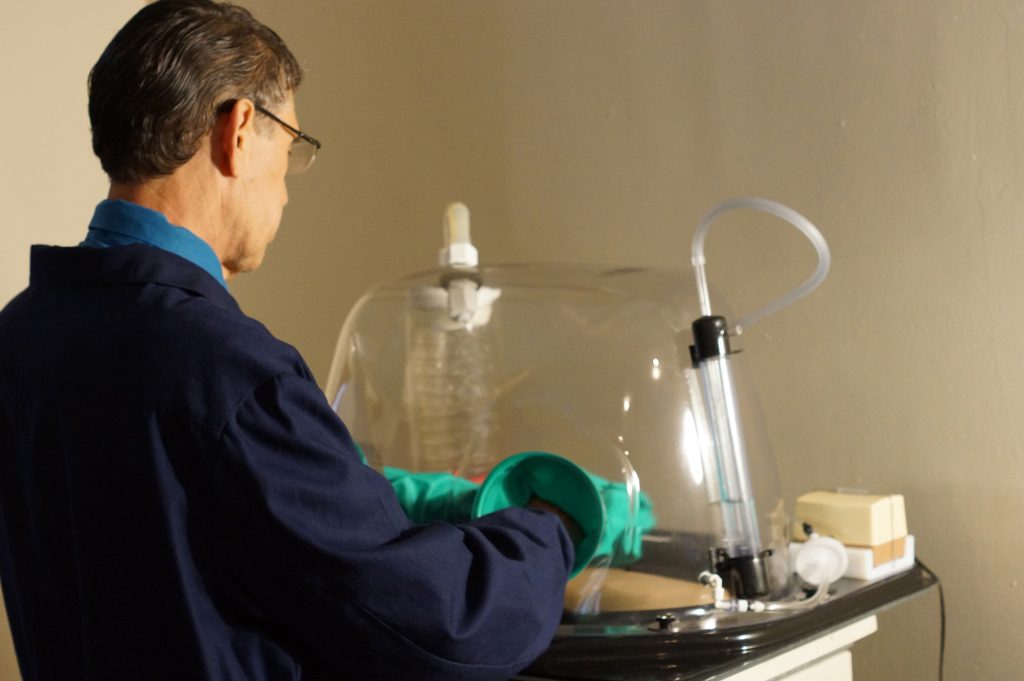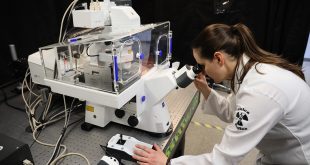By Ed Sullivan
Experiments often require using isolation and containment systems able to provide special atmospheres to establish and maintain specified conditions or protect experimental specimens from environmental contamination. This may require a clean, aseptic or controlled atmosphere to provide hypoxic, inert or dry conditions.
For R&D laboratories in cutting-edge research, securing grants and delivering required results demands consistent, repeatable, experimental measurements. While careful application of the scientific method is critical, the effectiveness of isolation to eliminate contaminants and other noise is also essential.
While this level of isolation is routine in sealed containers such as flasks or test tubes, when testing or additional physical manipulation is needed, it may require the use of a more complex containment or glove box system. The typical controlled atmosphere approach for decades was a heavy, automated glove box chamber. This featured a spacious chamber with solid metal walls, thick tempered glass and sophisticated sensors and control systems.
While massive, sophisticated isolation systems may deliver high purity atmosphere containment under ideal conditions, results are often disappointing in the lab. These large, complex machines are a major departure from the simplicity of work in a test tube or flask, and they can be overkill. When not essential, this large, complex isolation technology is a critical distraction. Such excess technical infrastructure generally comes with challenges for the researcher. These include more work and reduced reliability as it is generally more susceptible to malfunction and error, and requires more maintenance, setup, cleaning and calibration.
As a result, leading researchers seek simpler, more reliable isolation alternatives to the large complex glove box. The best of these “lean” isolation systems avoid much of the size and complexity, yet still ensure fail-safe isolation that meets experimental requirements. In doing so, they can eliminate the extra technological burden and greater risk of error, while avoiding distraction from their primary research goals. This can lead to quicker, more accurate experimental results.
Isolator Options for R&D
There are many types of large automated isolators, and lean isolation ranges from a simple flask to complex, automated benchtop glove boxes. With so many options, selecting a suitable alternative can be challenging.
At the lower end, glove bags are disposable containment devices of simple design that can be effective for simple process applications. Composed of inflatable plastic (e.g. PVC or PE) with built-in gloves, this approach can meet basic isolation needs if the lack of solid walls and pressure control are permissible. Compared to hard-walled workstations, glove bags are generally much easier to use and far less expensive; disadvantages include instability, reduced visibility and control issues.
Among lean glove box options are compact, portable benchtop models. Although they vary in size and weight, some are built with a clear, polymeric top with ports for a single pair of elastomeric gloves. Additional accessories and attachment options for items such as premixed or regulated gases may be part of the design.
The most basic of these isolator glove boxes simply act as a physical barrier. However, controlled atmosphere and clean units offer pressure control, displacement purge and fail-safe specimen protection for work in aseptic, inert and special gas mixtures.
Controlled atmospheres, clean or aseptic applications require positive pressure inside to protect the work specimen and inside atmosphere, while toxic or biohazardous work requires negative pressure containment to protect users and the community/environment.
While benchtop models cost less and have a smaller footprint than large, highly automated glove box chambers, many still feature greater layers of complexity in instrumentation and controls than required for the target process.
This has opened the door for new, leaner models with all required functionality for most research demanding a special atmosphere with a small fraction of the maintenance, footprint and operational complexity.
These lean glove box systems have already drawn the attention of a wide range researchers with technical and schedule challenges. Those isolation requirements vary from experiments on hypoxia in human diseases to those requiring aseptic containment for studying cures for the Ebola virus.
From the University Lab to West African Bush
“Several hypoxia chambers are available for research; however, their costs limit their availability to academic research facilities,” explains Aqeela Afzal, MS, PhD, MBA, Research Assistant Professor, Neurological Surgery at Vanderbilt University in Nashville, TN. Afzal’s research interests include Ischemic Stroke and Diabetic Retinopathy.
“Our basic area of study is stroke, which is caused by an Ischemic event in the brain. To study the effect of stroke on various cell types in the brain, we needed to culture the cells in a hypoxic environment,” says Afzal.
Since at least the 1960s, researchers have reported differential effects of culturing cells in reduced oxygen (hypoxia), and many researchers now routinely grow tumors, stem cells and embryos for in vitro fertilization under hypoxic conditions.
Afzal was also concerned about maintaining a sterile, humidified and warm environment for primary cells to be cultured long-term for the research.
In an effort to find an alternative to expensive digital isolator and containment workstations, Afzal’s team studied a variety of alternative chambers and found the Posi-Dome workstation would fit into their budget and matched their requirments for the study.
“In research, it’s always nice to have all the bells and whistles, the toys that are shiny and new,” says Afzal, referring to larger, more complex glove box chambers. However, these supernumerary items are not only not necessary for most research, they can actually be an interference. “We were able to obtain reliable hypoxia data and never had a problem with contamination,” she concluded.
Alistair Bolt, a pharmacist from England’s Norfolk and Norwich University Hospital, recently traveled to Sierra Leone, Africa, to play a vital role in the fight against Ebola in a trial run by Oxford University.
In a recent trial during his stay in Sierra Leone, Bolt also utilized a lean bench-type isolator. It was portable and rugged enough to work in tough field conditions.
Advantages of a Lean Glove Box
Lean glove box isolators and containment systems offer several advantages beyond the basic ability to produce reliable research results.
Benchtop model glove boxes are less complicated to install, use and maintain. Setup and training requires minutes, rather than weeks. The units are compact and portable so they can be quickly and easily moved from one work area to another or to distant field locations.
Some workstations have a transparent, curved, monocoque dome structure and are therefore much easier to clean and maintain than units with corners, ridges and light fixtures inside. Purging systems are less automated, but simpler, more energy efficient and safer than typical high-vacuum purge units.
For labs mindful of environmental impact, lean refers to the elimination of fans, heavy vacuum pumps and chemical treatment, reducing electrical demand while these smaller lighter units also have a much smaller carbon footprint.
When all the factors are considered – the reliability, flexibility, portability, and ease of use – lean glove boxes have the potential to deliver better, cleaner and quicker experimental results compared to traditional heavy, complex glove box chambers.
 BioLab Business Magazine Together, we reach farther into the Canadian Science community
BioLab Business Magazine Together, we reach farther into the Canadian Science community






